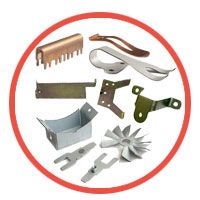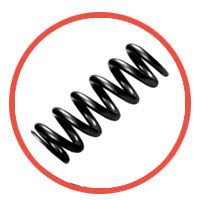
Torsion Springs
Torsion Springs are Helical Springs used to apply a Torque or store Rotational Energy. The common example of Torsion Spring is that used in a Clothes Pin. Torsion Springs are most commonly mounted on a Shaft / Mandrel, as they must be supported at Three or more points. The End configurations (legs) of Torsion Springs are numerous and are entirely dependent on the needed application. Legs can be Straight, Angled, Hooked or many other shapes as required to secure the ends during rotation. Torsion Springs can be designed to operate in either Clockwise or Anticlockwise direction but whenever possible they should be designed so that the Body Diameter decreases when a load is applied to the spring. The Double-Bodied Torsion Spring is a Single Spring but consists of Two Sets of coils, one set coiled Right Hand and one set coiled Left Hand. The Two Sets of coils will be connected each other, usually with an unwound section between the coils and work in parallel. The body coils of a Torsion Spring are usually close wound but can incorporate a pitch (spacing between the coils) if needed to reduce frictional losses. Applications: Torsion Springs are used in Clothes Pins, Clipboards, Garage Doors, Hinges, etc.
...more
Sheet Metal Component
Type :We are manufacturing different types of press components such as pricision tool. Material :CRCA, GP, MS, Copper, Brass and Alluminum.
...more
Extension Springs
Extension Springs are Helical Springs designed to store Energy and resist Pulling Force. The Spring used on a Screen Door is good example of the most common Extension Spring. Extension Springs must have a means for attaching them to components in your device or assembly. Ends can be Loops, Hooks, Threaded Inserts or Swivels. The end configurations on Extension Springs are unlimited but always perform the same basic function. Position of ends can be random or can be designed with specific orientation to each other and to the Extension Spring body. Stress present on Loops can be higher than those on Extension Spring body.
Material : Metal
Thickness : 1.5-2mm
Certification : ISI Certified
Application : Industrial Use
Color : Green
Feature : Corrosion Proof, Excellent Quality, Fine Finishing
Style : Coil
...more
Disc Spring
Use:Disc Spring is used for less Space and more load. Material:EN 47, EN 45, INC. X 750, INC. X 718, Spring Steel, AISI 304 and AISI 316 Range:Minimum Our
...more
Compression Springs
Compression Springs are Helical Springs with an Open-Coil configuration designed to store energy or to resist a force applied. The most common form of Compression Spring is Straight Cylindrical Coil Spring with the ends Squared (Closed), and a common example for same is Ball Point Pen Spring. Compression Springs are also manufactured in Conical, Barrel or Hourglass configurations. These forms of Compression Springs allows reduced Solid Height. Compression Springs are commonly wound with uniform spacing between the coils, however, variable coil spacing can be used to achieve improved performance against buckling and surging. A Compression Spring with variable Pitch assures a range of frequency response as opposed to the single significant frequency in a compression spring with constant pitch. Compression Springs are often installed to operate over a rod or inside a hole. These installations help reduce buckling of the spring body.
Material : Metal
Shape : Round
Thickness : 0-5-10mm
Color : Black
Application : Industrial Use
Finishing : Polished
Feature : Corrosion Proof, Durable, Easy To Fit
...more
Coil Springs
Usually Coil Spring comes in Various Types, but the Three Common Types of Coil Springs are Compression Springs, Extension Springs and Torsion Springs. Coil Springs are designed to satisfy Four Operating requirements i.e. Energy, Space, Environment and Service. Energy : All of the above Four Operating requirements Energy is considered on Priority in Coil Spring Design because a Spring is defined as a Device for Storing Energy and Energy is function of Load and Travel (Deflection), thus the Energy of Coil Springs can be specified as follows : 1. Two Loads at Two Lengths.2. Rate and a Load at a Length.3. Free Load and a Load at a Length. Space : Space is defined as the operating envelope, the area in which Coil Springs will be used. In case of a Compression Spring, this may be the hole into which the Spring fits, the rod over which it operates. Environment : Environmental factors include Heat, Cold and Corrosion. Select a material to suit the environment in which the Coil Springs operate and automatically choose a modulus of rigidity and material strength. Service : Finally, the intended Service of Coil Springs helps to decide how much of material strength should be use. Whether Coil Springs require Service i.e. Static or Dynamic?, Is the range of Stress is large or Small? These questions helps us to decide the ultimate strength to be used for Coil Springs. The Combination of above Four Operating requirements gives us a World Class Quality Product.
...more
Industrial Springs
Be first to Rate
Rate This